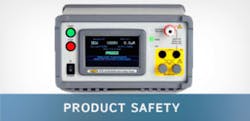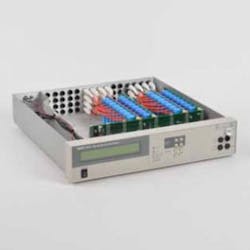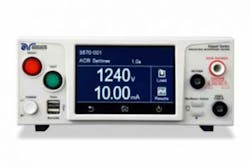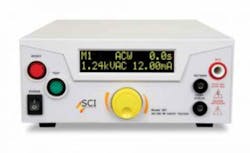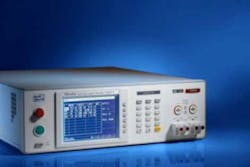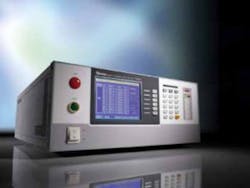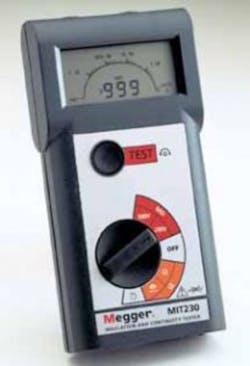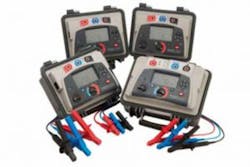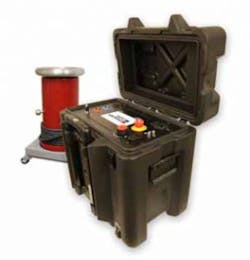Vendors support hipot, insulation- resistance, and ground-bond tests
To meet the requirements of your electrical safety testing applications, you can choose from a variety of instruments and systems that perform hipot, insulation-resistance (IR), ground-resistance, and ground-bond (GB) tests across a range of industries. Vendors offer a variety of options—from software that automates instrument control and records test results to a variety of test probes and leads. Relevant standards range from IEC 60601-11 for medical device testing to IEEE Std 43-20132 for testing the insulation resistance of electrical machinery.
From milliohms to megohms
Vitrek addresses product safety in a variety of application areas. Its products can test medical equipment, consumer appliances, communications equipment, and lighting while also finding use in industrial, aerospace, and automotive applications, according to Kevin Clark, president. “Vitrek offers two series of electrical safety testers—95x and V7x (Figure 1)—that each perform hipot tests as well as insulation-resistance (megohms), ground-resistance (milliohms), and ground-bond tests,” he said. “The product line also includes 964i high-voltage switching system for multiconductor applications” (Figure 2).
To help customers meet relevant standards, Clark said, “For new customers, we will work with them to identify the right model since we offer products with a range of options. For both new and existing customers, we offer guidance configuring the test parameters to meet the applicable standards’ test requirements.”
Vitrek also offers options, including software. “Our automated testing software facilitates the saving of time and money by increasing test throughput combined with built-in data gathering and reporting typically required by the National Recognized Testing Lab (NRTL) to confirm compliance with the applicable standard,” Clark said. (NRTLs include private-sector organizations recognized by Department of Labor’s Occupational Safety and Health Administration to perform certification for certain products to ensure that they meet the requirements of both the construction and general-industry OSHA electrical standards.) Clark added, “And as mentioned before, the 964i is a useful accessory when performing multichannel hipot and ground-bond tests.”
As for keeping operators safe, Clark said, “Our hipot testers include built-in high-side sensing that will automatically shut the unit down if the output current limit is exceeded.” In addition, he added, “We offer a high-voltage warning light to alert passersby that testing is in progress.”
When asked about unique product features, Clark said, “The V7x Series is our most popular line of hipot testers. It’s compact, lightweight, and convection-cooled (no fans) to reduce noise. It features the industry’s only color touchscreen, providing intuitive setup and operation.” He added, “The 95x Series is a higher-end line featuring up to 30-kV output voltage and high-resolution low-current measurement down to 1 pA.”
Clark continued, “Vitrek products are all designed and manufactured in the U.S. Vitrek electrical safety analyzers have a wide range of output voltages and power levels available—with AC hipot up to 30 kV and 500 VA and ground-bond up to 40 A. Vitrek offers DC hipot sourcing up to 50 mA to excel at charging and testing highly capacitive loads such as solar panels and filter banks.”
From IT to luminaires
“Ikonix USA serves any industry that requires electrical safety testing,” said Nick Piotrowski, product manager. “We cover a wide range of applications including, but not limited to, medical electrical equipment, consumer appliances, industrial equipment, IT and audio-video equipment, luminaires, X-ray scanning, and detection equipment. We also serve more unique applications such as thin-film materials testing and breakdown-voltage analysis.”
To serve such applications, Ikonix USA offers a variety of products. “Both the Associated Research and SCI divisions include product families to cover all aspects of electrical safety testing,” Piotrowski said. “Associated Research products are geared toward more advanced and automated applications to cover all electrical safety testing needs. Most of our testers are also compatible with our Autoware automation and control software, which allows users to set up test suites and record testing data.”
He added that Associated Research products incorporate new technology for a streamlined user experience and enhanced testing capability. He explained that the Hypot Series benchtop electrical safety testers (Figure 3) can perform hipot (5 kVAC, 6 kVDC), insulation-resistance (up to 1,000 VDC and 50 GΩ), and ground continuity testing. The HYAMP Series benchtop ground-bond testers provide the capability to output 40 AAC and ADC in a single model. And the HypotULTRA Series rack-mountable automated instruments can perform hipot (5 kVAC, 6 kVDC), insulation-resistance (up to 6,000 VDC and 50 GΩ), and point-to-point continuity (up to 10 kΩ) testing as well as ground-bond testing (up 40 AAC). The Hypot, HYAMP, and HypotULTRA all provide on-board test-data storage and a front-panel barcode connection, he noted.
Piotrowski also said the OMNIA Series rack-mountable automated instruments can perform the full suite of electrical safety testing: hipot (5 kVAC, 6 kVDC), insulation-resistance (up to 1,000 VDC and 50 GΩ), and point-to-point continuity (up to 10 kΩ) testing as well as ground-bond testing (up to 40 AAC). They can also perform leakage-current testing and include built-in MDs per the IEC 60990 standard. They can also perform patient leakage-current testing for medical-device testing in accordance with IEC 60601-13, and they offer functional-testing capabilities
Other Associated Research products, he said, include the HypotMAX higher voltage hipot instruments, which can test up to 20 kVAC and kVDC, and the SC6540 Series high-voltage and high-current multiplexers for automated multipoint electrical safety-testing applications.
Piotrowski described SCI products as efficient electrical safety testers applicable to benchtop testing. These products include the 290 Series benchtop electrical safety testers (Figure 4), which can perform hipot (5 kVAC, 6 kVDC) and insulation-resistance (up to 1,000 VDC and 1 GΩ) tests. “The user interface on the 290 Series is easy to use and designed to make electrical safety testing simple and efficient right out of the box,” he said. In addition, the 260 Series ground-bond testers come in two separate models: the 264 has a 40-AAC output and the 266 has a 60-AAC output. “Just like the 290 Series, the 260 Series is easy to use and allows you to begin testing right out of the box,” he said.
He cited other SCI products as well. The 4000 Series benchtop multifunctional tester is able to perform hipot (5 kVAC and kVDC), insulation-resistance (up to 1,000 VDC and 1 GΩ), and ground-bond testing (up to 30 AAC). The 6000 Series rack-mountable multifunctional tester can perform hipot (3.5 kVAC, 4 kVDC), insulation-resistance (up to 1,000 VDC and 1 GΩ), ground-bond (up 30 AAC), and leakage-current testing (including built in MDs per the IEC 60990 standard), and it also offers functional-testing capabilities.
Ikonix USA also offers several options to accommodate different application needs, Piotrowski said. In addition to Autoware test and control automation software, the company offers various test probes, including handheld probes for hipot and ground-bond testing, as well as a variety of test leads of different lengths and terminations. “For example, we offer a magnetic lead to connect to larger device enclosures,” he said.
The company also offers safe workstation accessories. “A device under test (DUT) enclosure works with the instrument interlock to disable output if enclosure door is opened,” he said. In addition, insulation mats allow an operator to be isolated from ground, and a dual-palm switch function requires that both switches be depressed for a safety tester to output voltage. The company also offers remote trigger hand and foot switches, high-voltage warning signs, and emergency-stop switches.
Full slate of tests in one box
“Chroma covers a wide spectrum of electrical safety testers that fit many different applications,” said Dan Carter, EST/LCR product manager. Products include standalone hipot testers, multichannel hipot testers that are capable of testing up to 100 DUTs simultaneously while providing individual readings for each one, electrical safety testing analyzers that can perform a full slate of EST tests out of one box, impulse winding testers, and ground-bond testers. “We are dedicated to helping our customers find a complete solution for their electrical safety testing that addresses each of their unique needs,” he said.
Carter said Chroma’s equipment covers a variety of test applications including medical equipment, appliances, IT equipment, wound components, motors and stators, battery cells, electric vehicles, and lighting equipment. “We are always looking for new applications and industries to provide solutions to, and are constantly innovating to meet new requirements,” he added.
Specific products include the Chroma 19032 Guardian electrical safety analyzer (Figure 5), which Carter described as six instruments in one, combining hipot, IR, GB, AC leakage-current (LC), DC LC, and dynamic-function tests. In addition, the Chroma 19053 Guardian hipot tester performs AC, DC, and IR tests and has a built-in 8-channel scanner, while the Chroma 19020 Guardian multichannel hipot tester can conduct tests on up to 100 DUTs simultaneously (Figure 6).
“Our electrical safety testing equipment is designed with compliance to safety standards in mind, while also helping our customers address pain points in their testing,“ Carter said. “Our goal is to make EST simple, safe, and reliable so that our customers can remain compliant while ensuring quality and safety on their production lines. For example, Chroma provides fully customizable automated test hardware and software designed specifically for medical device testing to IEC 60601-1 and IEC 60601-2-49 standards.” (Editor’s Note: IEC 60601-2-49 is being updated with IEC 80601-2-49:2018.4)
Carter elaborated on medical test, explaining that Chroma provides fully customizable automated test solutions designed specifically for medical device electronics, serving both R&D and production testing, in order to help customers meet global compliance requirements. “The Sentinel III System provides complete, fully automated electrical safety testing to IEC 60601-1 and IEC 60601-2-49,” he said. “Sentinel III also scans patient connections for leakage current without powering down the medical device.” He noted that the Sentinel III System can accommodate Class I, Class II, mains-powered, and internally powered medical devices.
Carter explained that the company’s CaptivATE software helps customers easily set up their test files, control their Chroma test equipment, save and export data, and create test reports. “Chroma also provides an IQOQ [Installation Qualification and Operation Qualification] version of the software to help with validation for medical customers, which can save our customers hours of time and alleviate some of the confusion that comes with validation,” he said. “Most of our equipment also has soft panels available for basic instrument-control and data-capturing capabilities.”
To enable operator safety, Carter said, “All of our EST equipment features a GFI circuit to sense current escaping to ground and shuts down the output in order to protect the test operator. Our equipment also features a safety interlock to be used with safety enclosures to prevent contact with a DUT during a test.”
Carter commented that although many pieces of test equipment can help meet the basic requirements of testing to standards, Chroma offers settings that can provide more insight into the quality of the product and the test procedure. Capabilities extend from an open/short check feature that helps manufacturers ensure that proper connections were made for the test to corona discharge-detection and discharge-level analysis, which can help detect potential weak points in a product’s insulation before a breakdown occurs. “Chroma also offers the ability to reference the model and serial number of the device under test to the test data for that same device, providing complete traceability for EST through the use of CaptivATE software,” he said. “Nearly all of our equipment offers some kind of additional quality checks that our customers find extremely valuable. This means that the testing is not simply done for compliance, but can also help improve the manufacturing process and ultimately help our customers deliver products that they can be confident in.”
Insulation resistance tests
According to Brian Hammerschmidt, applications specialist at Megger, the company makes its MIT Series insulation testers, which find use in consumer-appliance, lighting, industrial, and power-industry applications as well as in testing communications equipment and substation equipment, including transformers, circuit breakers, and bushings. He added that 10-kV and 15-kV MIT models are capable of testing to the IEEE 43-2000 standard (including typical insulation-resistance tests and polarization-index tests). The company also offers software applicable to electrical safety test. “Power dB software offers forms that assist with organization of data—which is important in reporting and verifying that tests have been performed and have passed standards,” he explained, adding that the instruments can perform insulation-resistance, timed-insulation-resistance, dielectric-absorption-ratio, polarization-index, dielectric-discharge, step-voltage, and ramp-diagnostic tests. They support high currents—3 mA short-circuit current—and offer high noise immunity, with 3 mA (5 kV and 10 kV) and 6 mA (15 kV) of noise rejection.
To ensure the safety of the operator who is using the equipment to perform high-voltage tests, Hammerschmidt said the MIT200 (Figure 7) and MIT300 Series meet the requirements of IEC61010-1 Cat III 600-V phase to earth, and the MIT400/2 Series meets CAT IV 600-V/CAT III 1,000 V. The MIT500 (Figure 8), MIT1025, and MIT1525 Series are safety-rated to CAT IV 600 V (5 kV, 10 kV) or CAT IV 1,000 V (15 kV). A range of 5-kV and 10-kV test leads are available plus dedicated 15-kV test leads, which are double-insulated with clips designed for 15-kV creepage paths, he said.
AC field testing
In related news, Haefely Hipotronics earlier this year introduced its 100-kV HVT-DI Series AC hipot testers, which the company described as the modern digital solution to AC field-testing of bucket trucks, aerial platforms, vacuum interrupters, breakers, switchgear, and other electrical apparatus. The 100-kV model (Figure 9) is designed for high output current—up to 100 mA at the 50-kV tap.
Also available are 30-kV, 60-kV, and 120-kV models. Each model includes a portable digital controls section and a bonnet and is complete with an input line cord, interconnecting cables, and ground lead. The company said the 120-kV model is specifically designed for ANSI/SIA A92.2 specification procedures for testing insulating booms on work platforms and bucket trucks. The 30-kV and 60-kV models are designed to perform quick and accurate AC dielectric tests. The instruments ensure accurate voltage and current measurements using a high-voltage divider and double current meter in the return leg of the high-voltage transformer. A guard circuit prevents stray or surface leakage from being measured by the current meter. Each unit is equipped with a fast-acting fuse, an external interlock, and E-stop.
Keeping up with requirements
Of course, companies making product-safety test instruments must keep up with industry trends to adequately serve their customers. “In addition to offering the electrical safety testing equipment required for product safety testing and certification, we remain very much in tune with the electrical safety testing industry,” said Piotrowski at Ikonix USA. “Due to the expertise and longevity of both our sales and application teams there are not many applications which we haven’t seen. I am on the IEC Technical Committee 66, which is the committee in charge of standards writing for the IEC 61010-1 standard.Syed Abidi, our applications leader, sits on the Product Safety and Compliance Committee for the Power Source Manufacturers Association (PSMA).” The company also offers applications consulting services, he said, adding, “We consult and train test operators and engineers on proper electrical safety-testing techniques, safe workstation setup and best practices, as well as in-depth IQOQ documentation and procedures.”
Why test?
Given the capable instruments described in this article, some may still pose the question, “Why test?”—as does a white paper from Associated Research.5 The question may seem obvious, but it demands a clear, concise answer. As Associated Research puts it, “There are four main reasons why you should safety-test your products prior to shipment”—
ensure that the product is not going to pose a hazard to the end user, detect workmanship defects and prevent faulty components from being installed, identify production problems before a product is shipped, prevent costly recalls, and prevent product liability suits because the responsibility of performing electrical safety tests ultimately rests on the manufacturer. EE
References
1. Medical electrical equipment, IEC 60601-1:2018 SER Series, International Electrotechnical Commission.
2. IEEE Recommended Practice for Testing Insulation Resistance of Electric Machinery, IEEE Std 43-2013 (Revision of IEEE Std 43-2000), IEEE Standards Association.
3. Methods of measurement of touch current and protective conductor current, IEC 60990:2016, International Electrotechnical Commission.
4. Particular requirements for the basic safety and essential performance of multifunction patient monitors, IEC 80601-2-49:2018, International Electrotechnical Commission.
5. Guide to Electrical Safety Testing, White Paper, Associated Research, 2016
For more information:
About the Author

Rick Nelson
Contributing Editor
Rick is currently Contributing Technical Editor. He was Executive Editor for EE in 2011-2018. Previously he served on several publications, including EDN and Vision Systems Design, and has received awards for signed editorials from the American Society of Business Publication Editors. He began as a design engineer at General Electric and Litton Industries and earned a BSEE degree from Penn State.
